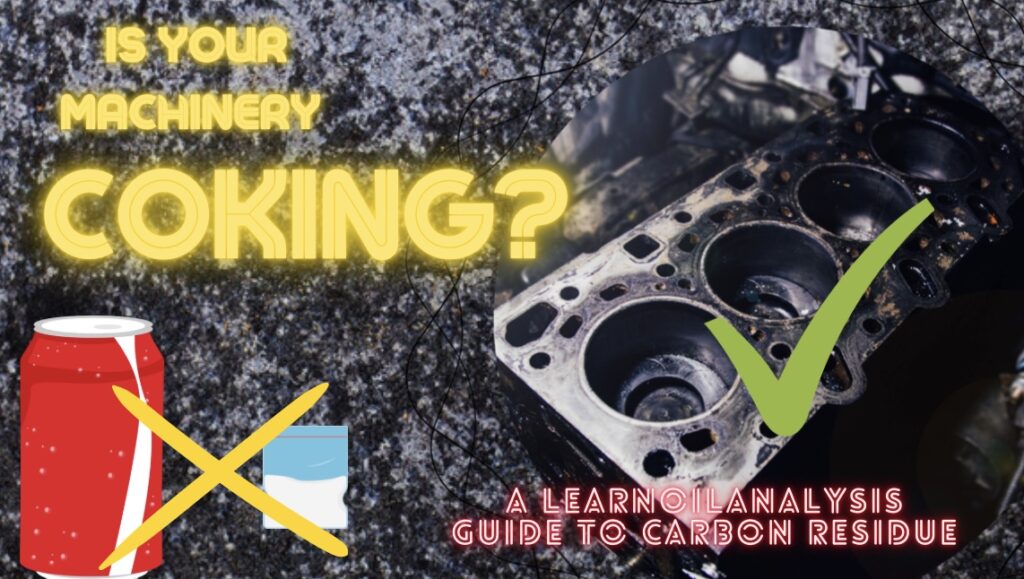
When I say coking, no it’s not drinking the worlds favourite cola beverage (other brands available) or the stuff that your favourite rock star is using as a nasal decongestant (other bands available). It is coke as in carbon I am referring to. Carbon residue is an important test on your oil and fuel to establish how trouble free it will be.
What is carbon residue?
Carbon residue is defined as the amount of carbonaceous residue formed after evaporation and pyrolysis of a lubricant or fuel.
In layman’s terms it’s how much tendency the fluid has to coking a system.
So what is coking?
Coking is the formation of black carbon sooty deposits that coat components. They can lead to insulation and inadequate cooling. Over time it can also cause the oil to thicken and sludge and eventually cause increased wear. The higher the temperature the harder, more brittle and pure black the deposit will become.
The conditions coking can form can be varied, for instance:
- Long exposure to high but not extreme heat – think of this the low and slow mechanism. Think of putting your dinner in the oven on a low heat and forgetting about it. This is more prone to areas of poor circulation especially near hotspots, but can also happen in slow moving flow pipe work. This is the common cause in heat exchangers.
- Thin film high temperature short exposure – think of this as putting a thin quick fry steak in the pan for a couple minutes too long on too high a heat. There is simply too much surface area exposed to the heat to cope even for a short period. This is the common cause in engine lubricating oils.
- Nebulised – this occurs with mists and vapours where there is max exposure to heat and leads to rapid thermal breakdown. This is the most common cause in fuels as they burn and form soot as well as in hydraulics with severe air entrainment called micro dieseling.
How is the test performed?
There are a few methods for measuring carbon residue. The classic two are Conradson and Ramsbottom methods, but both have largely been replaced by the newer and less messy for lab staff microcarbon method. The microcarbon method gives comparable data to the conradson method too which means there is no step change in data when switching. Hence most labs that can afford to will have migrated their clients onto the micro method unless there is a specific research or refinery process that requires the older methods. An illustration of the micro method is shown below.
So is all that is left at the end of the test, carbon?
Mostly yes, but sometimes additives in the oil contribute to the residue called ash content. You may have heard of low ash or low SAPS oils. Although not directly a result of the the base oil, metal additives such as anti-wear additives still contribute to the residue and can be thought of residue forming. If you want to know just the carbon content, the lab can perform a sulphated ash test and the difference is the carbon only residue. However, in practice this is seldom required as the main purpose is to identify the risk of deposits forming so whether they are carbon or additive ash is not necessarily overly important to the end machine user.
How does an increased carbon residue effect my machine?
Fuels and Engines lubes
Coking is a serious engine problem. It alters compression ratios, coats intake valves and reduces the volume of the compression chamber as well as the ability of the engine to breath. This naturally causes a lack of performance. This is why fuels have very low carbon residue values. In fact on many fuel specifications the value is so low the fuel has to be distilled to a 10% bottom fraction and then tested to enable a detectable level of carbon residue. The problem comes by the fact how much fuel the system goes through this tiny level of carbon over time can completely coat the inside of an engine and need a full de-coking.
Thermal oils
Carbonaceous deposits coat heat exchange surfaces dramatically decreasing deficiency over time. If unidentified, machine operators may try to compensate by increasing heat input which not only is costly but can further degrade the oil as for every 10’C increase you nominally half the life of the oil.
What should I do if I have a high carbon residue value?
As an oil ages it’s risk of forming residues increases as it degrades. Hence it is commonly seen to increase in high temperature or very long usage of a lubricant. The common solution is often an oil change, but if the oil is relatively new and has a high carbon residue value then the customer should discuss with their oil supplier the suitability of the oil for their specific application. For low temperature machinery conditions this may not be too much of a problem, but for higher temperatures or systems with hotspots this can be an important factor to discuss with your lubricant and fuel suppliers.
Find out more?
If you would like to find out more about testing your oil and fuels including carbon residue or you have any questions about fluid analysis then get in touch with the contact us button below.
